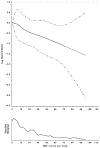Physical activity and male colorectal cancer survival
- PMID: 20008694
- PMCID: PMC2852183
- DOI: 10.1001/archinternmed.2009.412
Physical activity and male colorectal cancer survival
Abstract
Background: Although physically active individuals have a lower risk of developing colorectal cancer, few studies have examined whether exercise benefits colorectal cancer survivors.
Methods: Derived from the Health Professionals Follow-up Study, we studied colorectal cancer-specific and overall mortality in a cohort of 668 men with a history of stage I to stage III colorectal cancer according to predefined physical activity categories after diagnosis. To minimize bias by occult recurrences, we excluded men who died within 6 months of their postdiagnosis physical activity assessment.
Results: In a cohort of men with colorectal cancer and no apparent metastases at diagnosis, 50.4% exercised at least 18 metabolic equivalent task (MET) hours per week. Increased physical activity was significantly associated with improved colorectal cancer-specific mortality (P = .002 for trend) and overall mortality (P < .001 for trend). Men who engaged in more than 27 MET hours per week of physical activity had an adjusted hazard ratio for colorectal cancer-specific mortality of 0.47 (95% confidence interval, 0.24-0.92) compared with men who engaged in 3 or less MET hours per week of physical activity. The apparent benefit of physical activity was seen regardless of age, disease stage, body mass index, diagnosis year, tumor location, and prediagnosis physical activity.
Conclusion: In a large cohort of men with a history of nonmetastatic colorectal cancer, more physical activity was associated with a lower risk of colorectal cancer-specific and overall mortality.
Figures




Comment in
-
Physical activity: an investment that pays multiple health dividends: comment on "combined effects of cardiorespiratory fitness, not smoking, and normal waist girth on morbidity and mortality in men," "physical activity and survival in male colorectal cancer survival," "effects of a television viewing reduction on energy intake and expenditure in overweight and obese adults," and "physical activity and rapid decline in kidney function among older adults".Arch Intern Med. 2009 Dec 14;169(22):2124-7. doi: 10.1001/archinternmed.2009.413. Arch Intern Med. 2009. PMID: 20008697 No abstract available.
Similar articles
-
Associations of Physical Activity With Survival and Progression in Metastatic Colorectal Cancer: Results From Cancer and Leukemia Group B (Alliance)/SWOG 80405.J Clin Oncol. 2019 Oct 10;37(29):2620-2631. doi: 10.1200/JCO.19.01019. Epub 2019 Aug 13. J Clin Oncol. 2019. PMID: 31408415 Free PMC article.
-
Physical activity and survival after colorectal cancer diagnosis.J Clin Oncol. 2006 Aug 1;24(22):3527-34. doi: 10.1200/JCO.2006.06.0855. Epub 2006 Jul 5. J Clin Oncol. 2006. PMID: 16822844
-
Associations of recreational physical activity and leisure time spent sitting with colorectal cancer survival.J Clin Oncol. 2013 Mar 1;31(7):876-85. doi: 10.1200/JCO.2012.45.9735. Epub 2013 Jan 22. J Clin Oncol. 2013. PMID: 23341510
-
Physical activity in the prevention and treatment of colorectal carcinoma.Dtsch Arztebl Int. 2009 Oct;106(44):722-7. doi: 10.3238/arztebl.2009.0722. Epub 2009 Oct 30. Dtsch Arztebl Int. 2009. PMID: 19997551 Free PMC article. Review.
-
Role of physical activity and diet after colorectal cancer diagnosis.J Clin Oncol. 2015 Jun 1;33(16):1825-34. doi: 10.1200/JCO.2014.59.7799. Epub 2015 Apr 27. J Clin Oncol. 2015. PMID: 25918293 Free PMC article. Review.
Cited by
-
Serum lipid profiles and cancer risk in the context of obesity: four meta-analyses.J Cancer Epidemiol. 2013;2013:823849. doi: 10.1155/2013/823849. Epub 2013 Jan 20. J Cancer Epidemiol. 2013. PMID: 23401687 Free PMC article.
-
Exercise and cancer: return to work as a firefighter with ostomy after rectal carcinoma - a case report.Medicine (Baltimore). 2016 Jul;95(29):e4309. doi: 10.1097/MD.0000000000004309. Medicine (Baltimore). 2016. PMID: 27442677 Free PMC article.
-
Associations of Physical Activity With Survival and Progression in Metastatic Colorectal Cancer: Results From Cancer and Leukemia Group B (Alliance)/SWOG 80405.J Clin Oncol. 2019 Oct 10;37(29):2620-2631. doi: 10.1200/JCO.19.01019. Epub 2019 Aug 13. J Clin Oncol. 2019. PMID: 31408415 Free PMC article.
-
Energetics in colorectal and prostate cancer.J Clin Oncol. 2010 Sep 10;28(26):4066-73. doi: 10.1200/JCO.2009.26.8797. Epub 2010 Jul 19. J Clin Oncol. 2010. PMID: 20644082 Free PMC article. Review.
-
Associations of branched-chain amino acids with parameters of energy balance and survival in colorectal cancer patients: Results from the ColoCare Study.Metabolomics. 2018 Mar;2018(14):22. doi: 10.1007/s11306-017-1314-8. Epub 2018 Jan 31. Metabolomics. 2018. PMID: 29706852 Free PMC article.
References
-
- Jemal A, Siegel R, Ward E, et al. Cancer statistics, 2008. CA Cancer J Clin. 2008 Mar–Apr;58(2):71–96. - PubMed
-
- Giovannucci E. Modifiable risk factors for colon cancer. Gastroenterol Clin North Am. 2002 Dec;31(4):925–943. - PubMed
-
- Meyerhardt JA, Giovannucci EL, Holmes MD, et al. Physical activity and survival after colorectal cancer diagnosis. J Clin Oncol. 2006 Aug 1;24(22):3527–3534. - PubMed
Publication types
MeSH terms
Grants and funding
LinkOut - more resources
Full Text Sources
Medical
Miscellaneous

